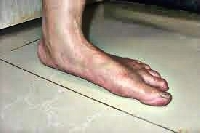
People who wear orthotic shoes include suffers of foot malfunction and pain
Anyone having trouble with his feet can benefit from wearing orthotic shoes. By the time it is all said and done, you may be wearing orthotic shoes instead of high heels and other pain-inducing footwear.
Those individuals suffering with foot problems are wise to clad their feet in this type of shoe because the footwear provides needed support and cushioning, relieving pain because the footwear corrects the inherent problem.
By definition, an orthotic is a brace, support or splint used to support and align as well as prevent or fix function of movable parts of the body, such as the foot.
Geometry of the Foot
Inserts change the geometry of a person’s posture, lifting various areas of the foot, altering the person’s posture in a good way. The outcome is relief from pinched nerves and modification in spinal and leg alignment.
When a person walks irregularly or abnormally due to a foot problem, orthotic footwear or insole inserts change the angles at which the foot hits the ground, correcting the problem and relieving pain.
This type footwear minimizes rotational movements as well as increases overall foot and arch support because the foot is held in place. This lessens stress on other body parts including the ankles, knees, hips and back.
A pair of orthotic footwear is not cheap. Less expensive inserts can be put into a regular pair of shoes. An arch support insert is an example of this.
~
Flat Feet
A flat footed person benefits when putting arch supports into his footwear, which provide physical support for the arch.
Too Much Arch
If the person’s problem is an excessively high arch, there are inserts design to address this issue.
What Can Happen
Muscles become damaged and feet stressed when the foot arch is too high or too low. Arch supports enable the foot to reconstruct the natural muscles in the arches.
Pronation
Footwear of this nature corrects pronation, which is the standard movement the foot makes, allowing it to absorb the impact from walking or running. Pronation occurs when the heel strikes the ground and the foot scatters the impact, widening and flattening the arch as the foot rolls inward.
The opposite of pronation is supination, a motion where the foot rolls on its outer edge, providing steadiness when a person walks or runs.
Pronation is required for the foot to operate properly; however, when the arch stays flat this causes the foot to roll inward too far, which leads to over-pronation. This results in strain on the foot and collapse of the arch, causing the foot to twist outward.
Those suffering from this condition end up walking on the inner edges of their feet, which causes misalignment of the muscles, ligaments and tendons in the foot, leg and back. Ultimately, muscular inadequacy occurs and the person can no longer walk quickly and loses endurance.
When flat feet and extreme pronation are not addressed and corrected this leads to bunions, calluses, heel pain, corn, shin splints, ankle sprains and knee-, hip- and back pain.
Options
A rigid orthotic device is one choice. It is made of firm material and controls foot function in the two major foot joints, lying right below the ankle joint.
A soft device absorbs shock, improves balance and eliminates pressure on sore or uncomfortable parts of the foot.
A semi-rigid appliance allows for dynamic balance of the foot when taking part in sports or walking. The appliance guides the foot through appropriate function, which lets tendons and muscles perform optimally.
When a person’s feet hurt, this impacts his life tremendously, and certainly not in a good way. It can interfere with work and physical activities. Ask a podiatrist (foot doctor) about this type of footwear or about inserts. You will be glad you did.
